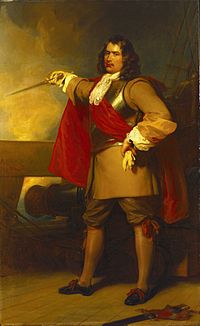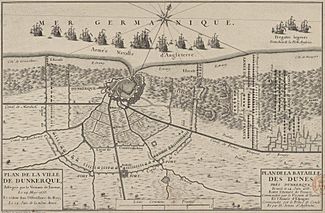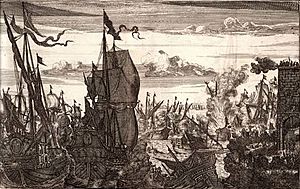Anglo-Spanish War (1654–1660) facts for kids
Quick facts for kids Anglo–Spanish War (1654–1660) |
|||||||||
|---|---|---|---|---|---|---|---|---|---|
| Part of the Franco-Spanish War | |||||||||
 The Battle of Santa Cruz de Tenerife (1657) |
|||||||||
|
|||||||||
| Belligerents | |||||||||
| Commanders and leaders | |||||||||
|
Caribbean: Spain: Flanders: |
Caribbean: Spain: Flanders: |
||||||||
The Anglo-Spanish War was a fight between England and Spain that lasted from 1654 to 1660. England was led by Oliver Cromwell during this time. The war started because both countries wanted to control trade and colonies. They attacked each other's ships and lands.
In 1655, England sent ships and soldiers to attack Spanish lands in the Caribbean. Later, in 1657, England teamed up with France. This made the war bigger, with battles happening in Europe, especially in the Spanish Netherlands. Even though the war officially ended in 1660, some fighting continued in the Caribbean for ten more years. Peace treaties were finally signed in Madrid in 1667 and 1670.
Contents
Why Did the War Start?
After a war with the Dutch, Oliver Cromwell, England's leader, looked at the ongoing fight between France and Spain. Both France and Spain were Catholic countries. Cromwell, a strong Protestant, believed Spain was a bigger threat to the Protestant faith in Europe.
He also wanted England to become rich again through trade, like in the days of Queen Elizabeth I. This meant attacking Spanish trade routes and treasure ships. People in England remembered famous explorers like Francis Drake and Walter Raleigh who did similar things. But this time, England also wanted to take over land, especially for growing sugar.
Cromwell made a deal with France in 1655 to fight against Spain. This alliance also helped Cromwell because France stopped supporting the old English royal family, the Stuarts. The Stuarts wanted to take back the English throne.
How the War Unfolded
England's Plan for the West Indies
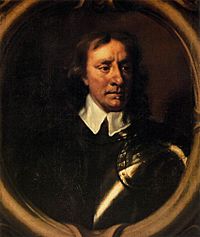
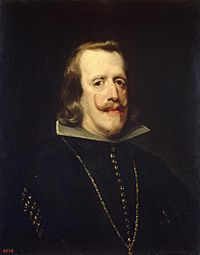
Cromwell had a plan called the Western Design. This plan aimed to attack Spain's colonies in the Spanish West Indies (the Caribbean). A large English fleet left England in December 1654. It arrived in the West Indies in January 1655.
In May 1655, an English force tried to capture Hispaniola island. This was a big attack with about 3,000 soldiers. However, the Spanish had made their defenses stronger. The English attack on Santo Domingo failed. Cromwell saw this failure as a bad sign.
Even though they failed at Hispaniola, the English then sailed to Jamaica. This island was not as well defended by Spain. They landed in May 1655 and took over the island. The Spanish tried to get Jamaica back, but they failed in battles in 1657 and 1658.
To protect Jamaica, the English governor invited Buccaneers (pirates who attacked Spanish ships) to live in Port Royal. These buccaneers helped defend the island. Jamaica became an important English possession, even though it was not very valuable at first. English captains like Christopher Myngs raided Spanish cities and bases, bringing back lots of treasure.
Battles at Sea
In April 1656, English Admiral Robert Blake led a fleet to block the Spanish port of Cadiz. This blockade lasted all summer. The Spanish ships stayed in port and did not attack. English ships also raided other Spanish ports, destroying many ships.
On September 8, 1656, one of Blake's captains, Richard Stayner, attacked a Spanish treasure fleet. He captured or sank most of their ships. This was a huge loss for Spain, costing them a lot of money. Blake kept his fleet at sea all winter, which was very unusual for that time.
In February 1657, Blake learned that another Spanish treasure fleet was coming from the Americas. He sailed to Santa Cruz de Tenerife in the Canary Islands. In April, Blake completely destroyed the Spanish fleet there. The Spanish had already unloaded their gold and silver, so Blake could not capture it. But this treasure could not be used by the Spanish government either.
Blake's actions hurt Spain's economy a lot. Spain relied on gold and silver from the Americas. However, England also lost many merchant ships to Spanish privateers. Spain started using Dutch ships for trade instead of their own.
Fighting in Flanders
In March 1657, England and France signed a deal called the Treaty of Paris. They agreed to fight Spain together in Flanders (part of modern-day Belgium). France would send 20,000 soldiers, and England would send 6,000 soldiers and its navy.
Their goal was to capture Spanish fortresses like Gravelines, Dunkirk, and Mardyck. Dunkirk was very important to England because Spanish privateers based there were attacking English trade ships. If England controlled Dunkirk, their trade would be safer.
The combined English and French army was led by the French Marshal Turenne. The Spanish army was led by Don Juan-José. The Spanish army also included about 3,000 English Royalists. These were supporters of the old English king, Charles II.
The English navy blocked the Flemish ports. The land campaign started late in 1657. Mardyck was captured in September. In May 1658, they began to attack Dunkirk. The Spanish tried to help Dunkirk, but they were defeated at the Battle of the Dunes on June 4. The English soldiers fought very well in this battle.
When Dunkirk surrendered on June 14, France gave the port to England, as they had agreed. This was a big win for England. It stopped many privateer attacks on English ships. English troops also helped France capture other towns in Flanders.
End of the War
The war between France and Spain ended in October 1659. Meanwhile, Oliver Cromwell died in 1658. This caused political problems in England. Eventually, Charles II returned to the throne in 1660.
After Charles II became king, the Anglo-Spanish War officially ended in September 1660. No new peace treaty was signed right away. Charles II had been allied with Spain before he became king.
What Happened Next?
Both England and Spain lost a lot of money during the war. Spain's economy was especially hurt by Blake's naval blockades. This made it harder for Spain to pay for its armies fighting in other parts of Europe. Spain fought back with privateers, which badly damaged English shipping. The Dutch benefited from this, taking over much of England's trade. However, England became a stronger naval power after this war.
Spain wanted England to return the lands taken by Cromwell, like Jamaica and Dunkirk. Charles II was at first willing to agree. But he became annoyed that Spain had not helped him return to the throne. So, he decided to keep Jamaica, Dunkirk, and Mardyck. He later sold Dunkirk to France in 1662 for money.
England and Portugal Team Up
In 1662, Charles II married a Portuguese princess, Catharine of Braganza. As part of this marriage, England gained control of Tangier and Bombay. England also agreed to help Portugal, which was fighting for its independence from Spain. British troops were sent to help Portugal.
These British troops helped Portugal win important battles against Spain, like the battle of Ameixial in 1663 and the Battle of Montes Claros in 1665. These victories helped Portugal secure its independence from Spain.
Pirates in the Caribbean
The fighting in the Caribbean continued for much longer. England wanted Spain to officially recognize its control of Jamaica and the Cayman Islands. The governor of Jamaica, Thomas Modyford, allowed buccaneers to attack Spanish ships and towns.
Famous buccaneers like Christopher Myngs and Henry Morgan raided Spanish cities. Myngs attacked Santiago de Cuba in 1662 and Campeche in 1663. Henry Morgan attacked Portobello in 1668 and defeated a Spanish fleet in Lake Maracaibo in 1669. Spain could do little to stop these attacks.
Spain's Queen Regent, Mariana, allowed her own privateers to attack English ships. Charles II then ordered Morgan to attack the Spanish again to secure Jamaica. In December 1670, Morgan captured Spanish islands and a fort. He planned to cross Panama.
Peace Treaties in Madrid
Spain was weak from many years of war. Charles II saw this as a chance for England to get good peace deals. Two important peace treaties were signed in Madrid.
The first treaty in 1667 was good for English trade. It also secured Portugal's independence. However, England's control of lands in the Caribbean was still not settled.
Three years later, in the 1670 Madrid treaty, Spain finally gave Jamaica and the Cayman Islands to Britain. This was a big win for England and a humiliation for Spain. English ships could now sail freely in the Caribbean. They were no longer seen as invaders or pirates.
News of this treaty arrived too late to stop Henry Morgan from attacking and burning Panama in 1671. Despite Spanish protests, Morgan was not punished. He claimed he did not know about the new treaty.
England and Spain later became allies in other European wars. They remained mostly at peace until 1702.
See also
 In Spanish: Guerra anglo-española (1655-1660) para niños
In Spanish: Guerra anglo-española (1655-1660) para niños
- Antonio de Vea expedition
- Military history of Britain
- History of Jamaica
|


